[/caption]
Employees at the Kennedy Space Center got together today to “build” their own space shuttle, to honor the shuttle program’s 30-year history. See a time-lapse video of how they did it, below:
Via the @NASAKennedy Twitter feed
[/caption]
Employees at the Kennedy Space Center got together today to “build” their own space shuttle, to honor the shuttle program’s 30-year history. See a time-lapse video of how they did it, below:
Via the @NASAKennedy Twitter feed

[/caption]
NASA’s Kennedy Space Center came under attack from the merciless Decepticons this week. However, Optimus Prime and his valiant band of Autobots fended them off, and then stood watch over the space center for the remainder of the week – along with the cast and crew of “Transformers 3, The Dark of the Moon.” Although the set was closed – there were some interesting revelations about what one can expect to see in the third installment of the highly-successful film franchise – including a very special guest star.
Journalists that were present on Oct. 7, for the delivery of STS-133’s payload were treated with the sights and sounds of Hollywood. Although these reporters and correspondents were kept on a very short leash the journalists present still managed to see the Autobots leader in truck mode, some actors in black soldier gear and some other tantalizing tidbits.
Numerous KSC employees have been selected to act as extras in the film. This serves the purpose of creating added realism to the film. Instead of training someone to “look” they know what they’re doing – more-likely-than-not those are the actual workers who do that job at America’s spaceport everyday. Outside of this film being a once-in-a-lifetime opportunity to appear in a big budget summer blockbuster, it also provided an opportunity to rub shoulders with real and upcoming movie stars.
Already, John Turturro, the actor that portrays Agent Simmons in the film has been spotted wheeling in and around the Vehicle Assembly Building. Shia LaBeouf (Sam Witwicky) has been seen with his character’s new love interest Rosie Huntington-Whiteley (Carly) wandering the set.
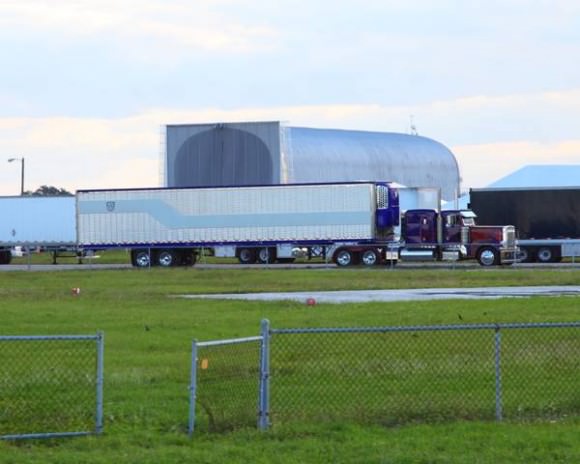
There is however one star whose presence in the film has been kept top secret. Her identity however, is crucial to the plot of the film which is said to revolve around the space age. She is none other – than the space shuttle Discovery. That’s right, the orbiter that returned America to flight twice is revealed to actually be a transformer. That is at least what sources close to the film are saying. Michael bay, the film’s director, had his computer hacked during the filming of the first Transformers movie and has been notorious about spreading disinformation.
For NASA, having a motion picture film at KSC is a no-brainer. The Transformers series of movies is very popular with children and young people and this allows them to relay the NASA story to a whole new audience.
“This gives us the chance to open up what we do, real space exploration to audiences that we may not already have in a blockbuster film,” said NASA’s KSC News Chief Allard Beutel. “We’re talking about a worldwide audience and it’s a natural fit in the sense that it is sci-fi and real space exploration but also it allows us to get into the theatres and let kids see what we do, inspire them to look into what NASA is all about and reach an audience we may not normally reach.”

[/caption]
Sunrises are beautiful almost any place in the world, but for some reason first light every morning over Central Florida is almost always breathtaking. Then, if you add into the mix a sunrise over Kennedy Space Center — America’s Spaceport — any space geek will likely melt with delight. Thanks to Jen Scheer, a shuttle technician at KSC, anyone can see the sunrise over the space center almost every day. Jen takes tons of images at KSC and shares them via Twitter (follow her @flyingjenny) and her Flickr page, but her specialty is taking a daily picture or two of the sunrise. “I’ve been taking sunrise pics since 2006,” Jen told me, “but only sporadically until early January of this year. That’s when I began stepping it up a bit, and it became a daily thing.”
Some of the images have some interesting landmarks or space-related features in them, too, such as the image above, or the one below that includes the Vertical Processing Facility which housed many parts of Hubble at one time, as well as Chandra and others. This image is especially poignant as that building was recently torn down. “In some of my sunrise pics, you can see the progression of it being dismantled,” Jen said.
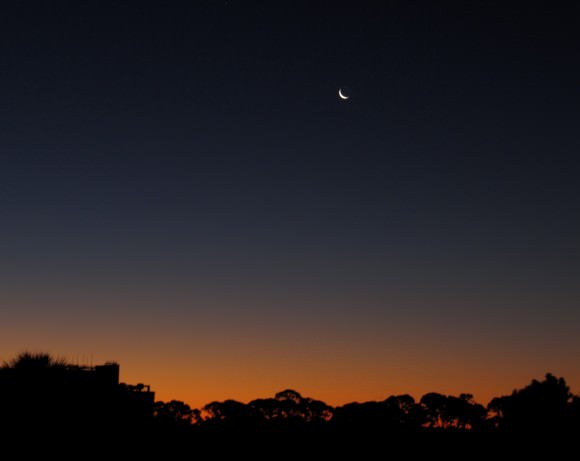
But don’t wait very long to take advantage of Jen’s marvelous photography. With the shuttle program ending soon, Jen’s job will be eliminated and she likely will not be working at KSC much longer. “We all love the shuttle program and will be very sad to see it come to an end,” Jen said. (Read our previous article, “Tough Times Could Be Ahead for Kennedy Space Center.“) “There are a lot of people who have no idea what they are going to do when it is all over. I’m looking into some possibilities, but we’ll just have to see how everything turns out.”
As an avid supporter of spaceflight, Jen also started the Space Tweep Society, an organization with a mission to “promote enthusiasm for all things space and to unite those inside the space industry with those who are outside looking in.” Check out the website for how you can get involved.
[/caption]
Even though today’s space shuttle launch took place during the early morning hours (Kennedy Space Center local time) the post-launch celebration meal for the launch control team consisted of hearty helpings of beans and cornbread. But that’s nothing new. Every single successful space shuttle launch since the very beginning of the shuttle program has been followed by beans and cornbread. It’s a tradition.
Even though the the Launch Control Center at Kennedy Space Center is one of the most unique “offices” in the world, like many other places of work, people bring in food to share with their co-workers. The story goes that when the launch teams were preparing for the very first shuttle flight in 1981, people would bring in covered dishes so the teams would have food during the long hours of tests and simulations. Norm Carlson, one of the test directors brought in a crockpot of beans along with some cornbread, and after the flawless STS-1 lift-off, the hungry team members rapidly consumed the delicious beans and cornbread.
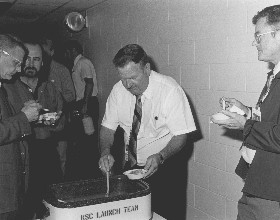
So, for the next flight, Carlson brought in two crockpots of beans and additional cornbread. Again, the beans and cornbread disappeared after STS-2.
A page on the KSC website tells the story:
“On each subsequent launch, Mr. Carlson kept bringing more crock pots filled with beans, and on each subsequent launch the beans would disappear in short order.
Finally, sensing that it was getting too difficult to bring in enough crock pots to feed everyone, Mr. Carlson switched to an 18 quart cooker, and set up shop on the fourth floor of the LCC, just above the firing rooms. The call “Beans are Go!” came to signal that the shuttle had successfully launched, and it was time to relax and unwind.”
The tradition continued, even after Carlson retired and now 60 gallons of beans are prepared for every launch as an official NASA function.
Since the phrase “full of beans” means having lots of energy and enthusiasm, it seems fitting that beans are part of the space shuttle tradition at KSC, and that tradition will undoubtedly live on along with the amazing legacy that the shuttle program encompasses. It seems almost unbelievable that perhaps only three more space shuttles will take flight.
The Inside KSC Blog provides what is thought to be the original recipe for Carlson’s beans:
Norm Carlson’s Space Beans Recipe
6 pounds Great Northern dried beans
10 pounds ham cut into cubes, plus ham bones
3 pounds chopped onions
2 stalks celery
1/2 shaker lemon pepper
1 teaspoon Liquid Smoke
Cover with water in an 18-quart electric cooker and cook 8-12 hours.
Sources: KSC website, Inside KSC blog
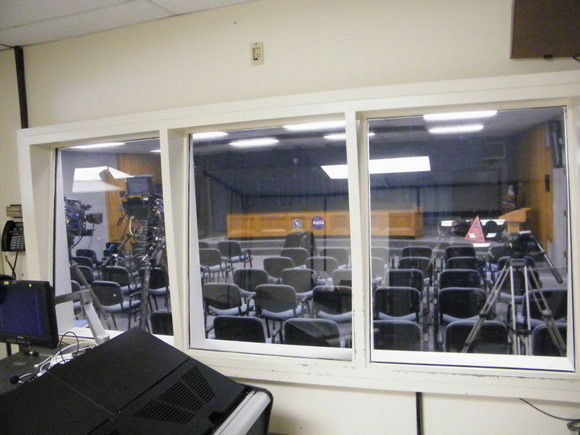
[/caption]
Listen to the audio of this podcast at this link.
You can also read the interviews below.
Hi, this is Nancy Atkinson from Universe Today. Right now I’m at Kennedy Space Center, and I’ve had the opportunity to see a couple of launches and cover other events that normally, I’d be back home watching on NASA TV. Since NASA TV is part of my daily diet of space media, I was very interested to see the newsroom, step in the auditorium where all the press conferences are held, and also talk with some of the people who work at NASA TV at Kennedy Space Center, or KSC TV as they call it, to find out about the work that they do, and also what it’s like to provide some of the most unique and exciting coverage anywhere on — and off — the planet. I chatted with producers, directors, technicians and other people who work behind the scenes, plus I also had the good fortune to talk with one of the voices of NASA TV, George Diller.
Here are some of our conversations.
Listen to the audio of this podcast at this link.
Allie Lee, Producer.
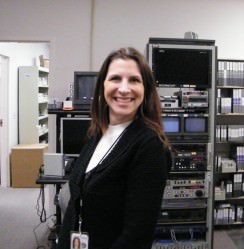
Nancy: I’m now here with Allie Lee and you are a producer for NASA TV?
Allie: I am, for Kennedy Space Center Television.
Nancy: What are some of the things you get to do. Or have to do?
Allie: I’m in charge or preparing the launch countdown show prior to launch and all the press conferences and media briefings that we do leading up to launch. But the most exciting thing that I get to do is work with the launch commentator, which a lot of times is George Diller, and work with him about what elements we’re going to put in the show, what things do we need to show on NASA TV, and I get to sit in the control room with all the fabulous employees that we have and watch the astronauts and the space shuttle get ready to launch.
Nancy: How long have you been here?
Allie: I’ve been here five years.
Nancy: Any memorable moments or times, or launches that you have been a part of?
Allie: I think the last launch was pretty special (STS-130). It happens to be the first one I got to do by myself as a producer. It was a fun launch, a beautiful launch in the evening. It was just wonderful to see the astronauts come out and get loaded up into the shuttle and wait for it and hear that countdown.
I would also say that another memorable flight would be STS-114, the return to flight. That was my first launch being here, and I happened to be pregnant with my little boy, so that was a nice launch.
Nancy: What are some of the challenges? Do you have to worry about timing and how you get everybody in and all the shots you want?
Allie: You do. There is a lot of tricks with it. As the producer you have to work very closely with the director who works closely with the field cameramen and the camera operators. You have to follow the astronauts schedule very closely and make sure that when a special milestone happens that the NASA TV commentator knows that it is happening, and that the director and the photographers all have that shot up on the TV so that everyone can see it and the commentator can talk about it.
You also have to be listening to the nets, to the loops and you get to listen all the people in the firing room discussing the launch. You have to listen for weather problems, weather issues. You have to listen for things that are going well, things that are not going well so that you can advise the NASA TV commentator so that he or she is preparing so they can give notice to the public, should they need to. So those are the things that are the challenges.
Working as a producer at Kennedy Space Center is a unique job, in that it is the only job like it in the world. So it is really special to me. It’s special to the whole team, but it is great to be part of this team.
Nancy: So, as you see the shuttle program coming to the end, does it…
Allie: It’s really sad. It’s really sad because we enjoy it so much and it is so beautiful. It’s going to be sad to see it go. I get to produce rocket launches, too, and those are wonderful. I’m excited that I get to be the producer for the last shuttle, I can tell you that.
Nancy: Thank you very much!
Dimitri Gerondidakis, Director.
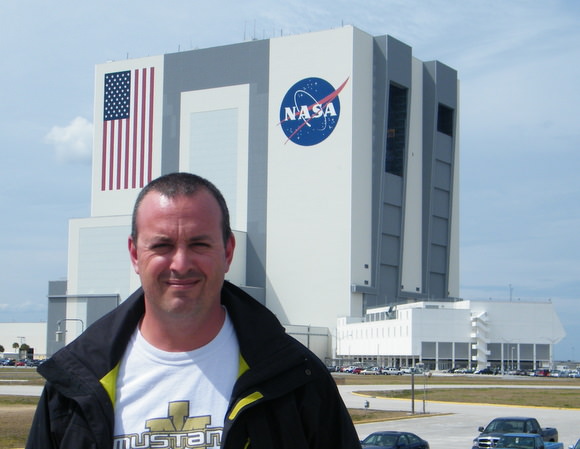
Nancy: And now I’m with Dimitri Gerondidakis. And you are one of the directors for NASA TV?
Dimitri: Yes.
Nancy: Can you me about a typical day for you, or the kinds of things you get to do?
Dimitri: Well, are you talking launch day?
Nancy: Launch day, that would be good!
Dimitri: OK, because every other day I’m just one of the troops and go out and get video and stills of different processing. But on launch day I’m lucky enough to get to direct the NASA TV launch coverage. Directing a shuttle launch is a lot different than directing news or sports or anything like that because with the shuttle launch there are actually required shots at certain times, for the paperwork for the engineers. There is a lot of timing out – at this time we need to show the engine and show the sparklers lighting the main engines. We need to stay with that shot until, what they call the mach diamonds form, coming out of the engines.
It’s not the most creative TV directing in the world, but it is no doubt exciting. The adrenaline really starts pumping.
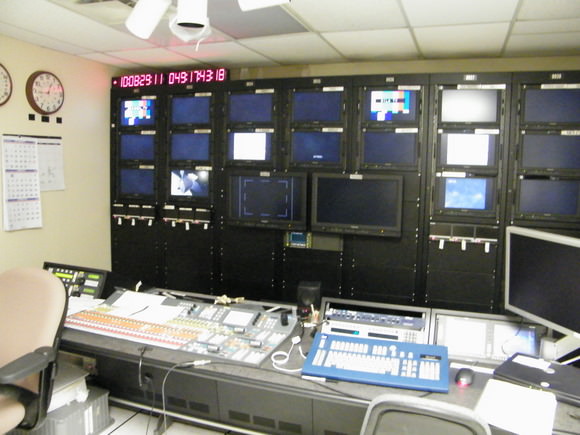
Nancy: So, you’re not only getting shots not only for us watching NASA TV, but for the engineers as well?
Dimitri: Right. I believe what I learned is that we were a news feed, so there are no dissolves; its straight cuts and stuff like that. And during the polls, we want to show the launch director polling his team. Whenever there are astronauts and we can see them, it is a required shot, like ingressing. If you watch the coverage you’ll notice that once we see astronauts we don’t get off of astronauts until they are no longer visible, like when they pull those cameras out of the crew cabin.
There’s room for some creativity, don’t get me wrong. I mostly rely on the awesome cameramen we have here that sometimes get to show their “artsy” side. They do a great job of it. Praise goes to them really. I just pick the shots I like!
Nancy: Well, I think it is always interesting to watch the launches for the variety of things you do get to see. You get to see behind the scenes – the astronauts going into the vehicle. That’s very interesting.
Dimitri: Oh yeah, that’s always a fun part of the show. There’s the part when we go into the Operations and Checkout building and we see them all suiting up and they are waving and this and that. And it’s anxious wait for us because we are waiting for them to pop out into that hallway. So while you’re trying to put on a decently entertaining good show/news feed, whatever you want to call it, you have your one eye on that hallway camera, because as soon as they come out…
Nancy: It’s one thing you don’t want to miss!
Dimitri: It’s an exciting part of the show. If the show were condensed down to 10 minutes you would probably start from there, the astronauts getting on, and coming out of the 9 minute hold.
Nancy: Right. For landing, is it kind of a waiting game like it is for the rest of us, you just have to wait and see when it is going to happen?
Dimitri: And there’s a little competition between the guys out there on the cameras who can see it first and get the shot. It’s funny, because typically they land from the north to the south, unless winds are… this is my opinion, I’m not sure if this is fact or not, but it seems to be the majority of the landings here. Well, we’re all rooting for a south to north because we have a camera on the VAB roof and you’ll see when it lands from south to north, we pullout with this big, beautiful shot with Titusville in the background, you got the rivers, the lagoons, and here’s the shuttle dropping in like a brick, almost. It just makes for a really cool shot. So there’s some friendly competition out there.
Nancy: So, coming up we have a night landing. I’m assuming that makes it a little bit harder?
Dimitri: Yeah, we don’t have our long range tracker, we have an infrared tracker which picks up a little heat signature. The first thing you see on the screen is this little white dot, and you’re going, is that it? Is that it? And finally it will start to take the shape of the shuttle and they’ll start tracking it and its pretty much infrared, which is not the prettiest picture in the world. Until I get that pilot’s point of view feed, and I’m not sure when I get it or why when I get it but you can see their point of view and the runway and the lights and then it becomes a little prettier, no doubt. Then it gets into the Xenon lights and it gets like daytime.
Nancy: Yeah, I bet! Any memorable moment that you’ve had in your time here? How long have you been with NASA?
Dimitri: I originally worked at NASA Headquarters and directed some shows there. I and a producer, my friend Tony, followed Sean O’Keefe around to different centers and did his NASA Update show. Came down here, I think it was five years ago. They were looking for someone to direct, and I asked the wife is she wanted to move to Florida and the kids loved it and so we did.
So the most memorable would have to be return to flight. The place was buzzing; it was my first. I kind of got thrown to the fire. I asked the bosses, can I watch someone else direct it first, because I have no idea what goes into it. “Nah, just get in there and do it!” So there was a lot of adrenalin and there were a lot of us new hires for return to flight, there were a lot of people here, the place was buzzing. It was probably the one I remember most.
Nancy: OK, thanks Dimitri!
Loren Mathre, Audio.
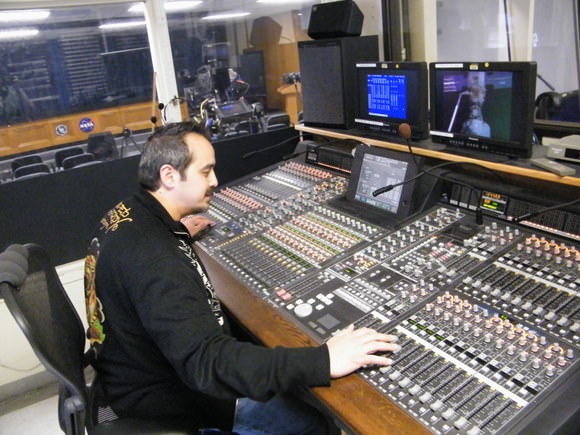
Nancy: And now I’m talking with…
Loren: Loren Mathre.
Nancy: And what do you do at NASA TV?
Loren: I work in the audio control room. We support NASA TV when it comes to any aspect of audio. For launches we put microphones out at the pad, we have one that’s maybe 100 feet from the orbiter itself and we pick up from the sparkler, so when you watch it on TV and you see the water dump and you hear that “whoooosh” and you hear the sparklers kick on, people just take it for granted that you hear that, but we have microphones out there. So we have one out there, we have one on the pad perimeter to pick it up as soon as it is launching. And then we put one on the beach, pointing straight up to get that low level rumbling you hear when the shuttle has launched.
Nancy: This was my first launch that I was here for, for Endeavour, and the thing that got me was the sound.
Loren: The sound is impressive!
Nancy: It engulfs you! So how do you – and I tried to record it and it just basically distorted everything, so what to you have to do to get good sound?
Loren: It is a fine mix. It is a different mix every launch depending on the weather, the temperature – sound travels at different levels, different speeds depending on what is in the atmosphere. The microphone we put out on the pad we’re only on that when the sparklers ignite on. Once the engines kick on you have to get off that immediately, or you have nothing but overdriven clipping noise. The pad perimeter mic, it overdrives immediately as well, but you have to ride that a little bit, so it’s a fine tuning of riding the fader and the trim pot until the microphone at the beach picks up the audio. Once the microphone at the beach picks up the audio, you’re pretty much good because the shuttle is so far away. That’s where you hear that low level crackling.
Nancy: How long have you worked here?
Loren: I’ve worked here in the TV department for 10 years. I used to be in the tech control, which is just systems, down in the industrial area. I don’t know if you’re familiar with that area – that’s where all the payloads are processed. But I was working down there for 10 years as well before I got laid off and re-called back up here. But when I was working 10 years up there I didn’t know of any of the operations up here. It’s funny how you get stuck in your own little world down there. So when I came up here it was a whole different aspect of the space program because we work hand in hand with the astronauts, you know, so you get to see them. And we handle all the press conferences, so you get to see the press conferences and you see the Administrator and Bill Gerstenmaier, all of them coming up, and you’re able to put a face and a personality to the people that are running the agency, and the astronauts themselves, so it’s a really good job.
Nancy: So, since it’s my first time here, it is my first time being at press conferences. So you’re always trying to get a shot at who is talking. How hard is that when you’ve got several people talking?
Loren: Press conferences are pretty easy, even when they are full houses. I don’t know if you were here when the NASA Administrator was here. That was a very big press conference. Normally we only have one mic handler out there, but we had two mic handlers just to handle questions from the media. It’s pretty easy, you just ride the levels. It’s nothing compared to a launch. Mixing launch audio is a tricky thing and when you get it just right you feel really good about it because not very often do you get it just right. There’s always something that afterwards you think, ‘oh, I could have gotten off that faster, I could have brought that other mic up faster.’ It’s just trial and error each time.
Nancy: And there is no do-overs.
Loren: There is no do-overs, right! A month later or so you get another shot at it. I have another audio control person out there. And we switch off launches. So when I mix a launch, he puts the mics out for me and send the signal back to me, and then when he mixes the launch, I do the same for him. So this is actually his launch, so I’m putting the microphones out for launch, and for landing – we put microphones on the runway for landings as well. Just things you take for granted that you see on TV – anything TV-wise, I always like to say, without audio KSC TV is just like a very expensive surveillance system. We add the extra to the launches and landings.
Nancy: I know! I watch NASA TV religiously and I know a lot of our listeners do to, so they will be very interested to hear about this kind of behind-the-scenes stuff.
Loren: Yeah, I went to my niece’s 5th grade class and talked about it, and you just take it for granted when you do it all the time. But I talked to my niece’s class earlier this year in January. Before me there was a police officer there and when I walked up the police officer was showing the kids his car. There was a karate instructor giving instructions on breaking boards. And here I am, I work at NASA TV, and I have a little boxful of astronaut pictures and other memorabilia, I thought, ‘This is going to be so bad.’ They loved it—the kids could not get enough about space! They had so many interesting questions for me – about a space elevator and living on the moon – these 5th graders were really interested and wanted to know more. They said I was the best – they had me signing autographs afterwards! I said, all I do is mix sound out there, but they just loved it. There is a lot of interest in the space program.
Maggie Persinger, Public Affairs/Multimedia
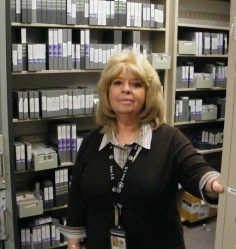
Nancy: And this is Maggie Persinger. And you get to work with all the fun technological things with video – can you tell us about that?
Maggie: Still and video. When anybody in the world from motion pictures, film, movies to newspapers, wants or needs something from KSC, or NASA, they come to me and I provide the research, the product, whatever it is that they need for their story, or for Clint Eastwood’s movie “Space Cowboys,” whatever it is. So it’s a lot. I not only deal with that, I have to make sure the jobs are shot, and that I get the copies, and I have to know the entire space program, what is going on everywhere. So it’s a difficult job for one person. There used to be three NASA people that did videos and two people did stills, so now I do it all.
Nancy: What has been the most interesting thing you’ve had to send videos or stills to?
Maggie: I think the most interesting were things like “Space Cowboys,” “Armegeddon,” “Contact,” things like that. When they used to come here and film, for a year and a half before they came and did that movie, I worked with the background people. I did things like provide them blanket pieces, tile pieces so they could build their sets. I got them the color chart for the ET tank. It was very long and involved. So whenever you deal with everybody – there’s a big Discovery program coming out about Australia. So I constantly am keeping track of these people and sending them new things. So there’s a lot of stories – there’s of interest around the world that people in Iowa don’t know realize. But I do! Because I deal with them so I know there is a lot of interest in the space program.
Nancy: I know that you are very busy even after press conferences, you are quickly handing out audio for us, it’s been great!
Maggie: That’s the thing, actually launch time is my easiest time. Even though you guys are here, I’m just dedicated to launch, all of you for this. It’s when you all leave and I have to get back to my routine when it gets tough. Because I’m dealing with the entire world, get everything shot, keeping up the library, making room – I’m constantly trying to make room for things, converting all the Quicktime files, — it’s busy. So everybody thinks it’s just busy at launch time! But launch time is my easiest time. I love launch day! It’s the rest of the time that is tough!
Nancy: Well thanks Maggie – it’s been great talking to you!
Maggie : It’s been good talking to you!
George Diller, Public Affairs Officer.
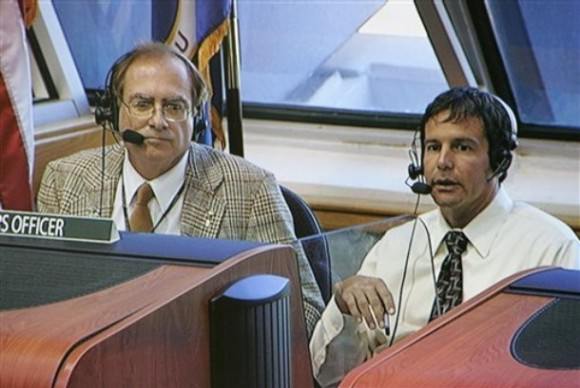
Nancy: The next voice you’ll hear you will probably recognize. He’s the voice of, I think almost all the launches here at Kennedy Space Center for the past several year. It’s George Diller. Hi George, thanks for talking with us today.
George: I do a lot of the launches but the shuttle launches we tend to spread out between among some of us in the office because there is a tremendous amount of preparation that goes into one of those so its hard for one person to do them all. I do do a lot more of the expendable launches, the unmanned launches and I really enjoy those particularly because the payloads are so different. They are deployable spacecraft that tend to be focused on space science, planetary exploration, astrophysics – those are the ones to me that have a certain amount of fascination, and always have way back from when I started here back in the late 70’s. In fact I cut my teeth as a newsman covering the space center for about five years and became particularly interested in the expendable vehicle launches with Viking, Voyager and Pioneer Venus. I’ve been here 29 years now and that still has the same attraction for me. We did launch those kinds of payloads on the shuttle for awhile and I got to work with those payloads in preparation for launch. But those all transitioned over to the expendable launch vehicles completely after the Challenger accident and the space shuttle was refocused on building the International Space Station.
If I look back probably at some of the missions that I have most enjoyed working on and doing the launch commentary for, probably the Hubble Space Telescope would the one that would be the highlight because I was directly involved with the telescope and the spacecraft payload testing and doing the commentary for launch, as well as for all the missions that have been done since that have gone up to service the telescope. So it really is quite a feeling to look back and say that I was a part of that for all of those Hubble Missions, both for the launch and all the flights that have followed to service it.
Probably the most memorable spacecraft that I have been directly involved with have been involved with particularly would be Cassini that went to Saturn and sent a probe down to Titan, one of Saturn’s moons. Also Galileo that went to Jupiter and that was such a great success and the Magellan mission to Venus. So, I think I enjoy those kinds of missions because they are leaving low Earth orbit and going so much farther out that we can only hope that one day we’ll one day go to those places ourselves.
The shuttle missions have really become focused on the space station, and it’s kind of been fun on those flights to focus on a particular piece of flight hardware that’s going up to be attached to the station, and later on when there is some kind of reference to a particular component or something particular that has been attached to it, you can remember some involvement that you’ve had with it.
But I think the space station, is, when is all finished and we look back at the science that was done over the next 10 or 15 years, I think we are going to look back at it as probably one of the wonders of the world in terms of modern accomplishments just as we have the Hubble Space Telescope, because I think so much will come out of it that is focused to us right down here on the ground. It will translate to benefits such as new metals, new pharmaceuticals, new computer substrates; new potential cures for diseases, medicines that we can get to synthesize only in the microgravity – zero gravity environment of The potential of the space station is almost mind boggling.
And I’m hoping to be around long enough to look back at the history of the space station program and say, well, I was with NASA when we were putting this together, and I may be retired eventually, but I can look back and say, look at all of the great things that now have come from the program.
Nancy: As you see the end of the space shuttle program coming, what are your personal feelings about that?
George: Well, the shuttle is something that gives us the kind of capability and flexibility that we never had before and that we do not have any plans to have again. It has the tremendous ability in terms of being able to deploy payloads, to take large payloads to space, to be able to services things in space, to be able to service things in space, to be able to construct things in space, also to be able to take things up and bring them back. And looking forward we’re going to have more capable rockets but they don’t have the same flexibility in terms of the weight that they can bring up or bring things back or be able to servicing that the shuttle has become so famous for being able to do for things already up there. So I think we’ll miss that, but it’s going to be fun to be able to look back and say the shuttle gave us the only way could have ever built the space station. I think it is a very storied program in the history of NASA. I’m proud to say I was here for the first launch and I’ll be here for the last launch and I was in some way a part of that story.
Nancy: Could you tell us about what it takes to put everything together to do a launch commentary for NASA TV?
George: The launch commentaries are, when you start planning for one, not only are there all the materials that you have to put together, but you also have to work with the TV people on all the things you want to show during the broadcast. That means scheduling all the video to be shot over a certain amount of time as the spacecraft is being prepared for launch, then all the things you want to do to tell the story, such as the animations you want to show and you have to figure out where in the broadcast its going to fit with what you are doing. Then have to schedule for it, so it’s a lot more than just writing it. Although there’s a lot of it now that, as far as the shuttle is concerned, I can work from an outline. I really don’t have to read from a script, although if I’m doing something very mission specific I might need a script for some part of it, if it is very mission specific. So, for anybody doing a launch commentary, it’s not something you can just pull together in just an afternoon. It takes a fair amount of time to pull all that together, and then work with the TV people and tell them where you want to include it and you have to work out your shot sheet of the sequence you want all these things in, so I think it’s good, in a way, that we kind of rotate the shuttle launches in particular around the office because it takes a fair amount of work to put it together. It’s a lot of fun, but it’s a lot of work!
Nancy: I’ve noticed that it seems recently you’ve had extra people come on and talk about different things going on with the mission during the launch countdown.
George: On the shuttle side, yes. On the ELV side we’ve always kind of done that. Our ELV commentary is usually divided into two parts, because the commentaries run usually between two and two and a half hours, as a rule on an unmanned launch. The first part of it picks up at a certain point in the countdown, but it is very heavy on interviews and things that are associated with the mission aspect. Usually you’re doing all that while they are fueling the vehicle. So, it gives you the chance to talk about fueling and things going on, but basically it gives you time for the color.
And then the second half of it is really focused on the launch itself and the launch operations. So it is divided into two parts that way.
On the shuttle, its more of a desire on the part of NASA to include much more activity both in terms of the mission as well as features that tell a story in the countdown and include more background that the average guy watching NASA TV can relate to. So it has meant more features, and some are related to the mission and some are related to the countdown, some are more related to the astronauts, some are more related to the people that have been involved with it, so we try to broaden it out a little bit. I think that is the reason behind that, because the count is on for such a long time. It’s one for five to five and a half hours. I think there was a feeling that we needed to do that and we had enough time to do that.
Nancy: I know I always enjoy watching as much as I can because it is fun to watch the whole process of what takes place. And now that I’ve been here and have gotten to see that, like the astronauts walking out and seeing it live and in person, its been really fun being here.
George: There have been a coupel that have almost been extravaganzas because of the nature of the mission, like the John Glenn mission. That one, there was so much you could include in the commentary because of the history of John Glenn. And he is so modest. He didn’t want us to do any more than we customarily do. But how can you not? And he is such a favorite around here. When he was here for the countdown dress rehearsal and the training, it was hard to get him through these exercises and these tests because he was just being mobbed by the NASA workers and the KSC employees. They were pulling dollar bills out of their wallets to get him to sign. And he would never be rushed. The trainers would try to keep things moving, but he would not be rushed. He took time to talk to everybody and sign their bills.
When we had the Challenger accident, he was the first person on site after the accident. He flew down here immediately and was on a briefing that afternoon over in the news center. He absolutely loves this place. He’s never forgotten it and those are the kinds of missions that have a lot of public interest. Plus the return to flight missions after Challenger and Columbia those were always big because in each case it meant a re-focusing of the program in some way. And of course the last one will just be a blowout.
Nancy: Thanks very much for talking with us today, this has been a lot of fun.
George: All right!
Nancy: I hope you enjoyed as much as I did the conversations I had with some of the people from NASA TV. NASA TV is available through many cable and satellite providers, and you can also watch it online. Go to www.nasa.gov/ntv. Reporting from Kennedy Space Center, this is Nancy Atkinson
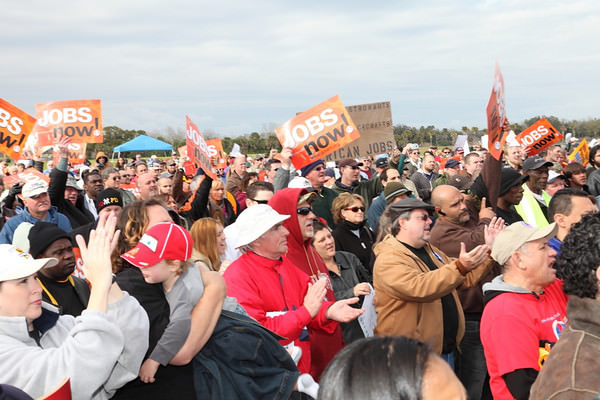
[/caption]
About 2,000 people turned out for a “Save Our Space Exploration” rally in Titusville, Florida on Saturday. Organized by union leaders, the event focused on preserving jobs at Kennedy Space Center, vital to the economy on the Space Coast. “Canceling the Constellation program is a movement away from what we Floridians know that we made happen,” said Brian Dempsey Secretary/Treasurer of Florida AFL/CIO. “Space Coast, space travel — that’s Florida. That’s what we’re known for. This is not a small matter. This is a huge fight that we’re going to have to buckle down to win. It’s going to take serious dedication and determination.”
No NASA officials spoke, but shuttle launch director Mike Leinbach was in attendance.
Speakers included union and community leaders, and each began with the words, “I’m one of the faces of the Space Coast, my family is worth fighting for, my community is worth fighting for, my job is worth fighting for.”
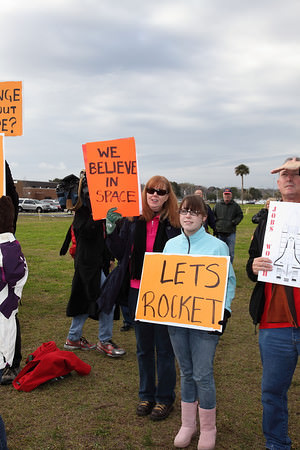
Any mention of commercial space companies or Russian space vehicles brought boos from the crowd. At the entrance at the Brevard County Community College, where the rally was held, people held signs that said “Impeach Obama.”
“We need to send a message to Congress and our President that what was announced a few weeks ago was not the last word,” said Glenda Linton, the National Secretary Treasurer of the Federation of Public and Private Employees. “We are here to send a message We will keep our jobs here in the United States and not give them to the likes of Russia and China. This is about lives, schools, businesses and everything that goes along with it.”
“I want to remind the President what he said right in that building over there, that he was going to save our jobs,” said Robin Fisher a Brevard county commissioner. He encouraged everyone to contact their legislators with the following words: “We urge you to call for endorsement for Constellation for a bold direction, and extension of the shuttle. We urge you to hold up all votes until Florida is taken care of. If that stops Washington, that’s OK. We want to stop Washington. Tell your legislators to cast no votes until the President gets it, that we must set a direction that is right for the US to preserve our leadership as a world economic superpower and military leadership that can only be achieved through space exploration.”
Organizers were expecting up to 5,000 people, but cold, rainy weather may have kept some at home. Many were bundled up in coats and blankets, but held signs that said “Jobs Now” or “We Believe in Space.”
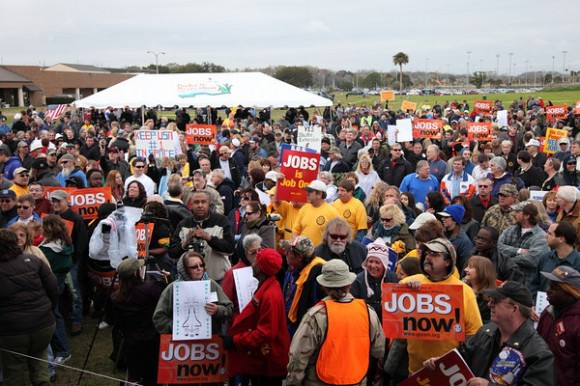
The Save Our Space group is organizing a video message campaign to send to members of Congress that will tell the personal stories of what will happen with the projected job losses, which could reach upwards 20,000, according to some sources. “Your face is the only one that can tell your story,” one speaker said.
“This is a time to build, a time to be innovative, a time to keep people working in the jobs they were trained to do,” he continued. “We are here today on this raining, cloudy and misty day to remind our leaders in Congress that this community is worth fighting for and these jobs are worth holding onto. We are not here to lay blame on anyone but to value the pride of this community and the work that we do in it. This is an example that we are willing to do to whatever we can to save our community and save our jobs.”
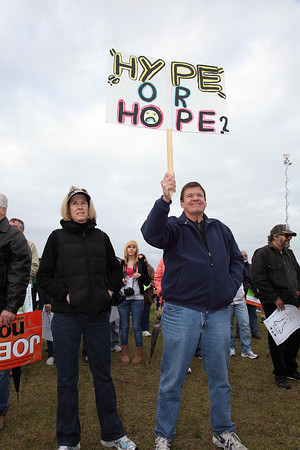
“This isn’t a crisis for just NASA workers, or union members,” said Executive Vice President of AFL/CIO Arleen Holt Baker. “This is a crisis of an entire community, and there are millions of brothers and sisters across America that are standing shoulder to shoulder with you, and they share your anger at the short-sighted decisions that are short changing your future. ”
[/caption]
The cancellation of the Constellation program compounds an already bleak picture for the Kennedy Space Center and those who work there. 7,000 shuttle workers are expected to lose their jobs by the time the shuttle program comes to an end by late 2010 or early 2011. So far, NASA has not provided an estimate of how many government and contractor jobs will be lost as Constellation — the program that would have sent astronauts back to the Moon — will be slashed. But it could be a hard blow to KSC and communities surrounding the space center.
“This is a big deal and it is going to affect us,” said Kennedy Space Center Director Bob Cabana about the cancellation at a press conference earlier this week. Shuttle launch director Mike Leinbach talked about the “shock” and “uncertainty” that many at KSC are feeling.
But Cabana said that when it comes time to launch the space shuttles, everyone is focused. “The workforce here is the most professional and dedicated I’ve ever seen,” he said.
And since the STS-130 mission is scheduled to launch on Super Bowl Sunday, Leinbach took the opportunity to use a football analogy.
“I asked everybody to treat these last five missions like a professional team. We can be down in the fourth quarter; we can be many, many points behind,” Leinbach said, “but we’re going to play every down and we’re going until the final whistle blows.”
But while NASA officials try to paint the best picture possible, the workforce is definitely feeling apprehensive. Roughly 2,100 NASA civil servants at KSC are expected to remain employed, with assignments shifting toward technology research and development. But most of KSC’s 11,000 shuttle program workers are employed by contractors. Without the shuttle and without a subsequent government-based program for human spaceflight, the jobs will likely disappear.
“The mood at work has been sort of somber for a while now, but it seems a bit more anxious now,” said Jen Scheer, a shuttle technician for a NASA contractor. “Morale is definitely very low. We all love the shuttle program and will be very sad to see it come to an end.”
Scheer and her husband both work at KSC, and have been preparing for potential layoffs by returning to college for additional degrees and looking to other options for potential careers.

“The announcement Monday (about the cancellation of Constellation) really didn’t even faze us- we pretty much expected it,” Scheer said. “But a lot of the people we work with did not have the same reaction. They wanted to believe the shuttle would be extended, or they would be selected to go on to the next program. Many are very scared now.”
In addition to lost jobs, the housing market surrounding the Cape is in trouble. “Due to the depressed market here, not much has been selling for about the past two or three years,” Scheer said. “Property values dropped so sharply that many of us owe more on our homes than they are worth. So we really can’t leave. But we’ve seen it coming, and we know what we have to do.”
Cabana also said he and his team saw the likelihood that Constellation would be canceled, and have dug in to prepare for the future. He firmly believes human spaceflight will continue at KSC. “Launch Complex 39 is not going to go to waste. The geography of Florida makes it perfect for launching to orbit,” Cabana said. “That’s a unique facility out there with unique assets, and I think they will be available for commercial use also.”
Cabana said they’ve begun to organize to better support future exploration so that KSC is not program-centric, but support centric. “We’re working to define what our role is in commercial space,” he said
Even NASA Administrator Charlie Bolden, speaking at a press conference on Saturday, said that while he can empathize with workers at KSC, he admits he can’t feel what they are feeling. He compared the end of Constellation to a death in the family. “Every body needs to understand that, and give them time to grieve and time to recover,” he said earlier this week. “I have an incredible work force, they have been through this before. This is part of life at NASA, and we manage to recover and go on and do great things.”
But Scheer and her husband continue to plan ahead. As a staunch supporter of spaceflight, Scheer began the Space Tweep Society, an organization with mission to “promote enthusiasm for all things space and to unite those inside the space industry with those who are outside looking in.” To expand what the popular Twitter-based organization does for space education and awareness, Scheer is looking to create a non-profit organization and is planning to apply for education grants. “I think our only hope is going to be to get money from outside this area,” she said. “There are a lot of positive things I want to do to keep the dream of space exploration alive in our country even in the absence of a manned program.”
For more info about the Space Tweep Society
Read Jen Scheer’s article on the Open NASA website about the end of the shuttle program
NASA’s Space Shuttle, which will make its last flight sometime later this year, has been a boon to the local economy surrounding the Kennedy Space Center, which is located in Cocoa, Florida. The closest county, Brevard, is where many of the workers that help maintain and launch the shuttle reside, and because of the presence of the space center, many a bar, restaurant, and local business have thrived.
This is in part due to those that work in the space industry, both for NASA itself and many of its private contractors. There are also the thousands of tourists that flock to the region to view launches and take tours of the Kennedy Space Center. All this, however, will change once the shuttle program is finished, and with five-year gap (at least) until the Constellation program gets rolling, the “Space Coast” may take quite a hit economically.
The end of the shuttle program will potentially eliminate as many as 7,000 – 8,000 jobs, some of which will need to be filled once again when the Constellation program is in full swing. But during the gap, many workers are expected to vacate the area in search of jobs elsewhere. This will impact the local economy that relies on these residents, and as many as 14,000 workers in the area may be indirectly affected.
According to a state study, in the 2008 fiscal year NASA generated $4.1 billion dollars in revenue and benefits for the state. $2.1 billion of that was in household income, and over 40,000 jobs were created due to NASA-related activities.
The local unemployment rate has already risen to 11.9 percent at present, largely due to the nationwide economic problems. Housing and construction have taken a hit as well, and will continue to suffer as the area sees the space workers leave.
This is the second time in NASA’s history that they’ve had to wind down a human space program, the first being the Apollo missions which ended in 1972. After the end of Apollo, Brevard county saw a dramatic downturn in the economy, as 10,000 workers left the region to find jobs and unemployment rose to 15 percent.
Estimations of the economic aftereffects of the end of the shuttle program aren’t as grim as those figures for the post-Apollo period, but there will be repercussions nonetheless.
There are several other factors that complicate the renewal of these lost jobs once the Constellation program starts up in earnest. Since Constellation utilizes a non-reusable launch system, fewer workers will be needed for repair and retrofit between launches.
Frank DiBello of the state agency Space Florida told Florida Today, “There is no escaping the transition that will occur when we go from a very labor intensive, reusable space flight system to one that is expendable. Simply by its nature, it is going to take a smaller workforce.”
Almost one-third of the current NASA employees working on the shuttle are up for retirement, so these posts would have been vacated anyway, and approximately 2,000 civil servants for NASA will retain their jobs over the gap between programs.
Though the region surrounding the Kennedy Space Center will surely struggle these next few years, it’s possible that many aerospace workers will flock to the private space industry during the gap, and companies like Virgin Galactic will benefit.
Source: Florida Today, Reuters